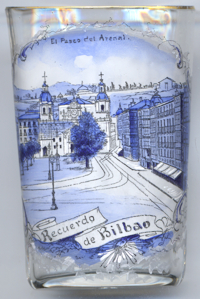

|
| ESPAÑA | Spain |
| Euskadi / País Vasco | Basque Country |
| Bizkaia / Vizcaya | Bizcaye |
Bilbao (Basque: Bilbo) is situated at an elevation of 8 m on the Ría de Bilbao, some 16 km upstream of where the river flows into the Bay of Biscay. Bilbao ist the capital of the province Bizkaia (Spanish: Vizcaya). At a population of about 344,100 (2022) in the city it is the largest city of the autonomous region Basque Country and the 11th-largest city in Spain. The metropolitan are has a population of about 910,000 (2020) and thus is the 6th-largest in Spain.
 The oldest traces (burial sites) of humans date back some 6,000 years, while the oldest remains of settlements date from the 3rd and
2nd century BC. Some authors identify the old settlement of Bilbao as Amanun Portus, cited by Pliny the Elder, or with
Flaviobriga, by Ptolemy. Bilbao was one of the first towns founded in the fourteenth century, during a period in which approximately
three-quarters of the Biscayan cities were developed, among them Portugalete in 1323, Ondarroa in 1327, Lekeitio
in 1335, and Mungia and Larrabetzu in 1376. Its municipal charter was issued in 1300 in Valladolid and confirmed in Burgos by King
Ferdinand IV of Castile in 1301. A new charter with further privileges was issued in 1310. In 1511 the Consulate of the Sea of Bilbao
was founded, under the control of which the city's port became one of the most important of the kingdom. The first book in the Basque
language was edited here in 1596. In 1602 Bilbao was made the capital of Biscay, a title previously held by Bermeo. The Napoleonic invasion
of Spain of the beginning 19th century saw the occupation of several Basque cities, but Bilbao was not among them. The Basque Country was
one of the main sites of battles during the First Carlist War (1833–1840). Despite the warfare,
Bilbao prospered during the 19th and 20th centuries, when it rose as the economic centre of the Basque Country. After the end of Francoist
Spain and the establishment of a constitutional monarchy, and with the approval of the Statute of Autonomy of the Basque Country in 1979,
Vitoria-Gasteiz was elected the seat of the government and therefore the de facto capital of the Basque Autonomous Community, although
Bilbao was larger and more powerful economically.
The oldest traces (burial sites) of humans date back some 6,000 years, while the oldest remains of settlements date from the 3rd and
2nd century BC. Some authors identify the old settlement of Bilbao as Amanun Portus, cited by Pliny the Elder, or with
Flaviobriga, by Ptolemy. Bilbao was one of the first towns founded in the fourteenth century, during a period in which approximately
three-quarters of the Biscayan cities were developed, among them Portugalete in 1323, Ondarroa in 1327, Lekeitio
in 1335, and Mungia and Larrabetzu in 1376. Its municipal charter was issued in 1300 in Valladolid and confirmed in Burgos by King
Ferdinand IV of Castile in 1301. A new charter with further privileges was issued in 1310. In 1511 the Consulate of the Sea of Bilbao
was founded, under the control of which the city's port became one of the most important of the kingdom. The first book in the Basque
language was edited here in 1596. In 1602 Bilbao was made the capital of Biscay, a title previously held by Bermeo. The Napoleonic invasion
of Spain of the beginning 19th century saw the occupation of several Basque cities, but Bilbao was not among them. The Basque Country was
one of the main sites of battles during the First Carlist War (1833–1840). Despite the warfare,
Bilbao prospered during the 19th and 20th centuries, when it rose as the economic centre of the Basque Country. After the end of Francoist
Spain and the establishment of a constitutional monarchy, and with the approval of the Statute of Autonomy of the Basque Country in 1979,
Vitoria-Gasteiz was elected the seat of the government and therefore the de facto capital of the Basque Autonomous Community, although
Bilbao was larger and more powerful economically.
Glass no. 4623 shows a view of Paseo del Arenal (Basque: Areatzako Pasealekua).
The  Iglesia de San Nicolás (San Nikolas eliza) [background] goes back to a hermitage
that presided over the fishing neighbourhood outside the town. The church was originally founded in 1490 and was dedicated to St. Nicholas
of Bari. However, that church was later destroyed by floods and had to be demolished. It was replaced by the current church in 1756. The
church had to close during the War of Independence, in 1816 it was struck by lightning and in the Carlist Wars it was a military warehouse.
For all this it was not open to worship in 1808–1814, 1835–1841 and 1873–1879.
Iglesia de San Nicolás (San Nikolas eliza) [background] goes back to a hermitage
that presided over the fishing neighbourhood outside the town. The church was originally founded in 1490 and was dedicated to St. Nicholas
of Bari. However, that church was later destroyed by floods and had to be demolished. It was replaced by the current church in 1756. The
church had to close during the War of Independence, in 1816 it was struck by lightning and in the Carlist Wars it was a military warehouse.
For all this it was not open to worship in 1808–1814, 1835–1841 and 1873–1879.
[https://de.wikipedia.org/wiki/Bilbao, https://en.wikipedia.org/wiki/Bilbao;
https://de.wikipedia.org/wiki/Liste_der_St%C3%A4dte_in_Spanien;
https://es.wikipedia.org/wiki/Iglesia_de_San_Nicol%C3%A1s_(Bilbao)]
![[scale]](lineal.jpg)